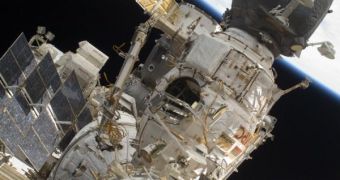More than 10 years ago, sixteen nations embarked on one of the most ambitious projects in the world, the construction of an orbital facility meant to provide the contributing countries with the opportunity to conduct zero-gravity scientific experiments, as well as to make other scientific observations from outside the planet's atmosphere. Tomorrow, the coronation of this decade of hard work will take place, once the ISS deploys its last set of solar panel arrays, which will complete its power supply.
A lot of work has been required to get here, and nobody at mission control is taking this task lightly. The $298-million set of wings is the last one to be outfitted to the facility, and, together with the existing arrays, will supply the station with roughly the same amount of energy 42 average households use. The S5 truss rod segment, attached to the starboard side of the lab's “backbone” yesterday, holds the new panels, which are now neatly stacked inside closed boxes on its extremities.
“We have made solar array deploys exciting in the past. Pins and needles? Yes, a little bit (...) it's kind of the nature of the game,” the space station mission management team leader, NASA official Dan Hartmann, shared yesterday evening. The new event is all the more exciting if we take into account what happened when the last similar array was deployed. One of the panels got caught in a wire and tore. Engineers back on Earth sought desperately a solution, and the damage was eventually fixed during a very stressful spacewalk.
“Right now, the biggest threat that I see, barring some problem with the mechanism, are gaps in communications. We may simply not get through the deployment of both solar arrays before we're required by our mission rules to maneuver back to equilibrium,” Kwatsi Alibaruho, the flight director of the space station, said on Thursday.
During the delicate maneuvers required by the deployment of the solar panels, the ISS will have to leave its optimum trajectory, so that the new additions fly directly under the sunlight. This step is mandatory, if they are to warm up and not be damaged by the stretching process. Alibaruho's concern is that the astronauts may be unable to receive word that they have to put the station back on its correct track in time, and that something might go amiss.
Hopefully, that will not be the case, and everything will run smoothly, as it did during yesterday's spacewalk. The process is already underway, as it began at 10:58 am EDT (1458 GMT). “We're looking forward to it. There will be all kinds of emotions and, hopefully, jubilation at the end,” Hartmann told before the last stage of the station's construction started.

 14 DAY TRIAL //
14 DAY TRIAL //